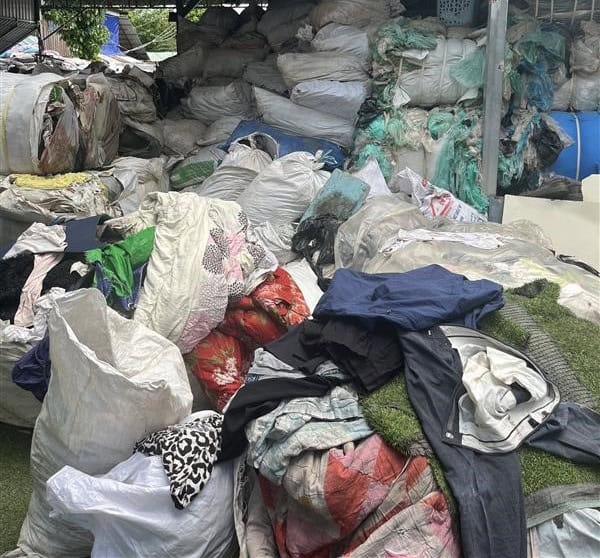Fast Fashion Destroys the Environment
What adorns our bodies as fashion is often discarded after a short time and ends up in landfills or rivers – with devastating consequences for the environment.
Clothing as a fast-moving consumer good
Western society produces and consumes clothing on an unprecedented scale. If we were to stop producing new clothing today, we could easily clothe the next six generations. This illustrates how strongly our behavior is shaped by fast trends, constant changes, and a short-lived understanding of fashion – driven in part by the low prices of some fast fashion providers.
The rapid consumption of clothing has enormous impacts on nature: the production process requires massive amounts of water and simultaneously generates significant CO₂ emissions. The chemicals used pose risks to human health and pollute the environment. Ultimately, the barely worn garments end up in illegal landfills, rivers, or simply scattered in the environment.
The ecological impact of the textile industry
The rapid trends of the fashion industry are heating up the climate: the textile sector is responsible for ten percent of global CO₂ emissions – more than the entire aviation industry. This makes the textile industry the third-largest emitter of CO₂, as many fast fashion products are made from synthetic fibers derived from petroleum, which already generate significant CO₂ emissions during production.
In addition, clothing production requires vast amounts of water. It takes as much as 60 liters to dye just one kilogram of yarn. The contaminated water often ends up untreated in rivers and other bodies of water, poisoning the habitats of numerous animals and plants.
During manufacturing, clothing is bleached, dyed, and printed, often using highly toxic chemicals. Approximately one kilogram of chemicals is used per kilogram of clothing. These substances endanger the health of workers, enter the environment through wastewater, and are released into nature when garments are stored in landfills or burned uncontrolled.

The used clothing myth
ChatGPT:
The myth of secondhand clothing being shipped to other countries for continued use no longer holds up, not even as a façade. Images of massive textile landfills have long reached the media in the Western world.
Most clothing donations are shipped in huge bales – often to countries in the Global South, as Greenpeace has noted. There, the items that can still be sold are sorted out, but the vast majority of Western secondhand clothes end up in landfills of unimaginable scale. Waste management systems in these destination countries are usually not equipped to handle such enormous volumes of textile waste, and further processing is complex and expensive.
As a result, the discarded clothes from the Western world lie in massive landfills, rivers, or other bodies of water. The polyester gradually breaks down into microplastics, and the chemicals leach out of the garments, contaminating groundwater or polluting the air when burned.
Fast Fashion exceeds EU safety limits
Together with the Consumer Protection division of the Chamber of Labor in Upper Austria, the Austrian environmental NGO GLOBAL 2000 conducted a spot check of 20 clothing items from ultra fast fashion giants such as Temu and Shein. In 7 out of the 20 items, multiple EU safety limits were massively exceeded, meaning they clearly should not be sold within the EU.
This included the limit for PFCA-like substances, which exceeded the EU threshold by 4,000 times. PFCA-like substances can accumulate in the body and cause cancer and thyroid disorders. Additionally, the limits for plasticizers were clearly exceeded; plasticizers are known to be reproductive toxins and can act hormonally.
Textile waste at the everwave site in Cambodia
Cambodia itself is a production hub for the international textile industry. Yet the country is increasingly confronted with textile waste it did not produce, generated instead by overproduction and the throwaway mentality of other countries. The existing waste management infrastructure is unable to cope with this flood. Tons of unworn or barely worn clothing end up on illegal dumps, along riverbanks, or directly in the water – the Mekong and its tributaries becoming the final destination of our consumption.
A closer look at the waste collected daily by the everwave boat from the Mekong shows that 10% of it consists of textiles. Of these textiles, approximately 70% are still in good condition – neither worn out nor damaged. These 70% are still wearable yet end up in the waste streams.

Calls for regulation of fast fashion providers
Globally, we produce far more clothing than is actually needed. Much of it ends up in global waste streams barely worn – not because it is damaged, but simply because it becomes superfluous in an oversaturated market.
As a result, NGOs and environmental organizations are calling for regulation of fast fashion brands. This should include strengthening supply chain laws and introducing an anti-fast fashion law modeled after the French example. The French legislative proposal requires ultra fast fashion providers to adhere to stricter advertising rules and to pay up to five euros per item if products such as pants, sweaters, or shoes are of poor quality and must be discarded.
Although this law currently targets only providers outside the EU, such as Temu or Shein, and excludes other brands like H&M or Primark, it represents a first step in the right direction toward curbing the fast fashion industry.


